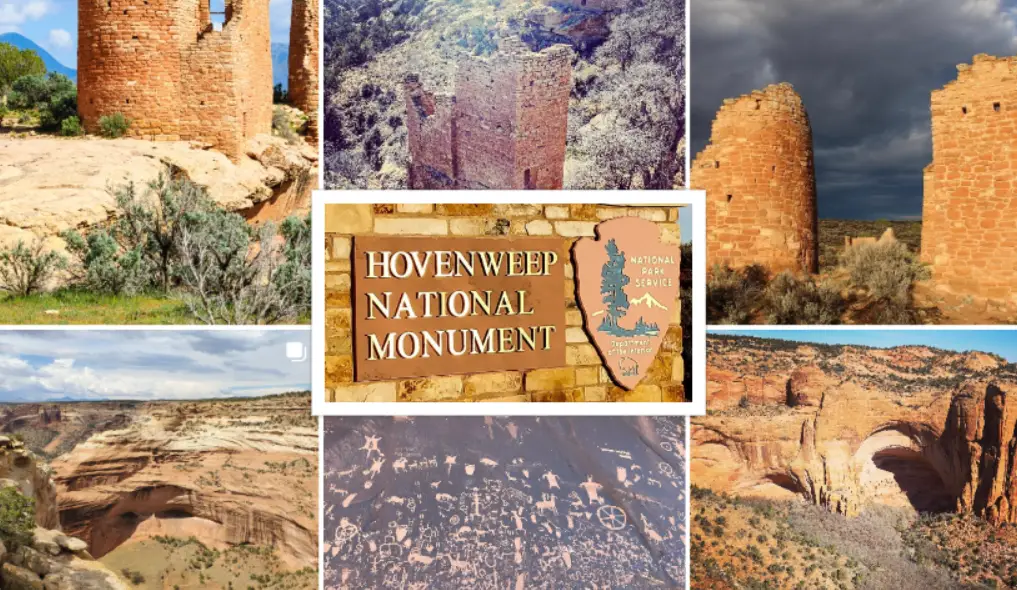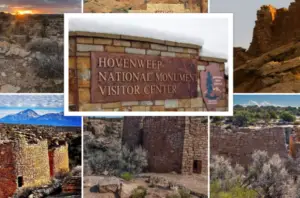Hovenweep National Monument : Interesting Facts, History & Travel Guide

- By
- Aparna Patel
- |
- 1 Apr, 2023
- |

Hovenweep National Monument is a hidden gem located on the Colorado Plateau in the southwestern United States. It is home to some of the most unique and well-preserved examples of prehistoric Puebloan architecture in the region, including multi-story towers, kivas, and dwellings.
In this blog post, we’ll explore the history and significance of Hovenweep National Monument, as well as provide a comprehensive travel guide for visitors looking to explore this incredible park. From hiking trails to ranger-led programs, we’ll cover everything you need to know to plan your visit to this fascinating destination. So pack your bags and get ready to discover the wonders of Hovenweep National Monument!
- Hovenweep National Monument is located on the border of southeastern Utah and southwestern Colorado in the United States. It covers a total area of about 784 acres.
- The name “Hovenweep” comes from the Ute word “Hovenweepatapawi,” which means “deserted valley.”
- The monument features a series of six prehistoric villages built by the ancestral Puebloan people between 1200 and 1300 AD. The structures include towers, kivas, and multi-roomed dwellings, many of which are well-preserved.
- The towers at Hovenweep are particularly notable, as they are some of the most unique and well-preserved examples of prehistoric architecture in the American Southwest. The towers range in height from one to three stories and are often built on the edges of cliffs or atop boulders.
- The area was declared a national monument in 1923 by President Warren G. Harding, and it is now managed by the National Park Service.
- In addition to the prehistoric ruins, the monument is also known for its stunning natural beauty, including canyons, mesas, and sandstone cliffs.
- Hovenweep National Monument is home to a wide variety of wildlife, including mule deer, coyotes, bobcats, and many species of birds.
- Visitors to Hovenweep can explore the ruins and hiking trails, attend ranger-led programs, stargaze, and camp in the park’s designated campground.
- The monument is considered sacred by many Native American tribes, and visitors are asked to treat the area with respect and reverence.
- Hovenweep National Monument is located near several other notable archaeological sites, including Mesa Verde National Park and Canyon of the Ancients National Monument, making it a popular destination for those interested in the history and culture of the American Southwest.
Travel Guide for Hovenweep National Monument
Getting there: The monument is accessible by car, and there are two entrances: the Square Tower Group entrance, located in Utah, and the Cajon Group entrance, located in Colorado. The closest major airports are in Durango, Colorado, and Grand Junction, Colorado.
When to go: The best time to visit Hovenweep National Monument is in the spring or fall, when the weather is mild and the crowds are smaller. Summers can be hot and dry, while winters can be cold and snowy.
Read More:
- Hohokam Pima National Monument : Interesting Facts, History & Travel Guide
- Harriet Tubman Underground Railroad National Monument : Interesting Facts, History & Travel Guide
- Hanford Reach National Monument : Interesting Facts, History & Travel Guide
- Hagerman Fossil Beds National Monument : Interesting Facts, History & Travel Guide
- Grand Staircase–Escalante National Monument : Interesting Facts, History & Travel Guide
- Grand Portage National Monument : Interesting Facts, History & Travel Guide
Things to do:
There are several things to do at Hovenweep National Monument, including:
- Explore the prehistoric ruins: The monument features a series of six prehistoric villages built by the ancestral Puebloan people between 1200 and 1300 AD. Visitors can explore the ruins on foot and learn about the history and culture of the people who once lived there.
- Attend ranger-led programs: The park offers a variety of ranger-led programs, including guided hikes, stargazing, and cultural demonstrations.
- Go hiking: There are several hiking trails at Hovenweep, ranging from easy to strenuous. The trails offer stunning views of the surrounding canyons, mesas, and sandstone cliffs.
- Camp: The monument has a designated campground with 31 sites, including 6 walk-in sites. The campground is open year-round and has restrooms, drinking water, and picnic tables.
- Stargaze: Hovenweep is known for its dark skies and is a great place for stargazing. The monument offers several stargazing programs throughout the year.
- Take a scenic drive: The monument is located in a beautiful, remote area with stunning scenery. Visitors can take a scenic drive on the park’s paved and dirt roads to see the area’s natural beauty.
Tips for visiting:
Here are a few tips to make the most of your visit to Hovenweep National Monument:
- Bring plenty of water, sunscreen, and a hat, as the area can get hot and dry.
- Wear sturdy shoes, as the hiking trails can be rocky and uneven.
- Respect the ancient ruins and do not climb on or touch the structures.
- Leave no trace and pack out all trash.
- Check the park’s website for updated information on closures and weather conditions.
- If you plan to camp, make a reservation in advance, as sites can fill up quickly.
Information & History of Hovenweep National Monument
Hovenweep National Monument is a protected area located on the Colorado Plateau in the southwestern United States. The monument covers an area of about 784 acres and includes six prehistoric Puebloan villages dating from the 13th century.
The name Hovenweep comes from the Ute language and means “deserted valley.” The ancestral Puebloan people who lived in the area between 1200 and 1300 AD built multi-story towers, kivas, and dwellings from the local sandstone. The buildings are unique for their precise masonry and elaborate architecture, and they stand as testament to the sophistication of the ancestral Puebloan civilization.
The six villages that make up Hovenweep National Monument are spread out across a 20-mile radius along the Colorado-Utah border. The villages are divided into two groups: the Square Tower Group and the Cajon Group. The Square Tower Group includes the largest and most well-known structures, including the namesake Square Tower, which is a three-story tower that stands 40 feet tall. The Cajon Group includes smaller structures and is located in a remote, rugged canyon.
The first European to discover Hovenweep was W.H. Jackson, a photographer with the United States Geological Survey, who stumbled upon the ruins in 1874. In the early 20th century, archaeologists began studying the area, and in 1923, President Warren G. Harding declared Hovenweep a national monument.
Today, Hovenweep National Monument is managed by the National Park Service and is a popular destination for hikers, campers, and history buffs. Visitors can explore the ruins on self-guided tours, attend ranger-led programs, and camp in the park’s designated campground. The monument is also home to a wide variety of wildlife, including mule deer, coyotes, and many species of birds.
More Articles:
- Grand Canyon–Parashant National Monument : Interesting Facts, History & Travel Guide
- Governors Island National Monument : Interesting Facts, History & Travel Guide
- Gold Butte National Monument : Interesting Facts, History & Travel Guide
- Gila Cliff Dwellings National Monument : Interesting Facts, History & Travel Guide
- Giant Sequoia National Monument : Interesting Facts, History & Travel Guide
- George Washington Carver National Monument : Interesting Facts, History & Travel Guide
Some frequently asked questions about Hovenweep National Monument:
Q: What is the best time to visit Hovenweep National Monument?
A: The best time to visit Hovenweep National Monument is in the spring or fall, when the weather is mild and the crowds are smaller. Summers can be hot and dry, while winters can be cold and snowy.
Q: How do I get to Hovenweep National Monument?
A: Hovenweep National Monument is accessible by car, and there are two entrances: the Square Tower Group entrance, located in Utah, and the Cajon Group entrance, located in Colorado. The nearest major airports are in Durango, Colorado, and Grand Junction, Colorado.
Q: Can I camp at Hovenweep National Monument?
A: Yes, the monument has a designated campground with 31 sites, including 6 walk-in sites. The campground is open year-round and has restrooms, drinking water, and picnic tables.
Q: Are there hiking trails at Hovenweep National Monument?
A: Yes, there are several hiking trails at Hovenweep, ranging from easy to strenuous. The trails offer stunning views of the surrounding canyons, mesas, and sandstone cliffs.
Q: Are the ruins at Hovenweep National Monument open to the public?
A: Yes, the prehistoric ruins at Hovenweep National Monument are open to the public and can be explored on foot. Visitors are asked to respect the ruins and not climb on or touch the structures.
Q: Can I bring my pet to Hovenweep National Monument?
A: Pets are allowed in Hovenweep National Monument, but they must be kept on a leash at all times and are not allowed on hiking trails or in buildings.
Q: Are there ranger-led programs at Hovenweep National Monument?
A: Yes, the park offers a variety of ranger-led programs, including guided hikes, stargazing, and cultural demonstrations. Check the park’s website for updated information on programs and schedules.
Q: What is the history of Hovenweep National Monument?
A: Hovenweep National Monument includes six prehistoric Puebloan villages dating from the 13th century. The ancestral Puebloan people who lived in the area built multi-story towers, kivas, and dwellings from the local sandstone. The buildings are unique for their precise masonry and elaborate architecture, and they stand as testament to the sophistication of the ancestral Puebloan civilization.
Search Posts
Latest posts
-
4 Mar, 2024
How can I do a "broad" search for flights?
-
4 Mar, 2024
How to make dining alone less awkward?
-
5 Mar, 2024
How to avoid drinking vodka?
Popular posts
-
5 Mar, 2024
Why prohibit engine braking?
